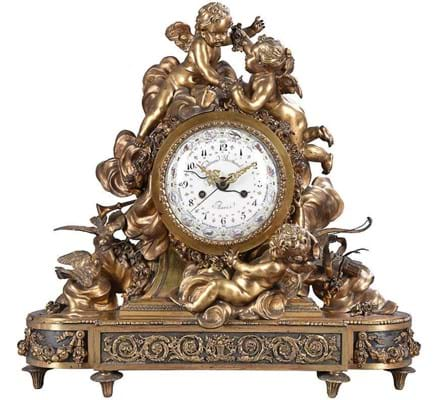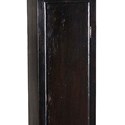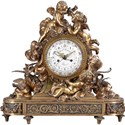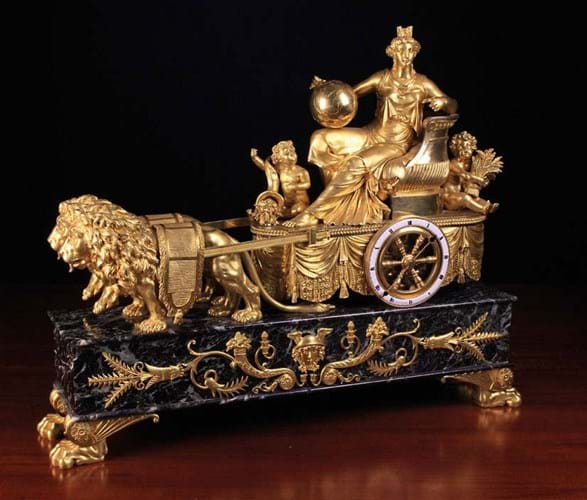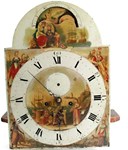Autumn sales allow for a quick check on the time, at least on how it has been told from the Golden Age to Art Deco via the showy magnificence of the French Empire.
It was the latter category which led the way at the eagerly anticipated specialist clock sales at Dreweatts (15% buyer’s premium) put together and comprehensively catalogued by Leighton Gillibrand.
Top-seller at the Newbury rooms on October was a 2ft 2in (66cm) Louis XVI-style ormolu figural mantel clock c.1830 which combined the skills of two major names of French horology.
The movement, two-train, bell striking movement with a fine pinwheel deadbeat escapement was signed by Pierre-Honoré-César Pons (1773-1850).
He had hoped to specialise in precision horology at the Paris workshop he opened in 1803 but, to meet his bills, supplied movements to eminent clock makers of the period.
One was his influential friend Ferdinand Berthoud. whose name was inscribed on the 7½in (19cm) diameter enamel dial polychrome painted in the manner of Coteau.
Honoured throughout his life, first by Napoleon and later by Louis-Phillipe, Pons’ name is as attractive as ever it was and the clock, estimated at £7000-10,000, sold to a US dealer at £19,000.
Chariot pulled by lions
Yet more ornate was the Empire gilt bronze Le Char de Cérès clock offered at Wilkinson’s (20% buyer’s premium) in Doncaster on September 29.
Depicting the goddess in her chariot pulled by lions with the enamel dial sited in a chariot wheel, the 20in (51cm) tall creation was catalogued ‘after’ the famous bronzier Pierre-Philippe Thomire (1751-1843) with an earlier movement signed for early 18th century clockmaker Julien De Roy (1686-1759). Pitched at £14,000-15,000, it was allowed to sell to a UK buyer at £11,600 but may well prove a shrewd buy. A TEFAF dealer later shown a picture of the clock believed the case, although perhaps regilded, was certainly by Thomire.
Swiss-based specialist Richard Redding told ATG: “This is truly a magnificent piece, for sure Empire and for sure the case is by Thomire. I would not be surprised to see it emerge in the near future with an Empire movement.”
Major name appeal
In the flat-lining market of longcase clocks, a major name is more important than ever.
The London maker Michael Knight is not well known outside the specialist world but an 800- word catalogue entry by Gillibrand suggests it should be.
Born c.1659, Knight was apprenticed to Tompion in the 1670s and was free of the Clockmaker’s Company in 1681. Today, only 10 of his longcases are known but the value of a c.1705 ebonised clock signed to the 12in (31cm) brass dial Mich Knight, London Fecit lay as much in the quality as the rarity.
As with most of Knight’s known pieces, it bears similarities with the work of this former master.
Gilibrand concluded that this was “a Tompion in all but name” with both the case and the movement “almost indistinguishable from Tompion’s work exhibiting an abundance of features diagnostic of his workshop”. However, the market price proved quite different. The longcase was estimated at £8000- 12,000 by Dreweatts and sold to a UK collector at £13,000.
More widely known today is Joseph Windmills and for better reasons than just his memorable name.
“He was competing with some of the finest clockmakers that have ever lived,” writes Gillibrand. “In this environment Windmills excelled, producing clocks of a quality that equalled many of his more famous peers.”
On offer at Newbury was his 6ft 9in (2.06m) tall figure walnut and marquetry cased clock with windows to the side and an oval lenticle to the door. Dated c.1695, it had a five-finned and latched pillar-striking movement with anchor escapement and was signed to the matted centre of the 11in square brass dial.
It sold to a UK collector a shade over estimate at £8200.



